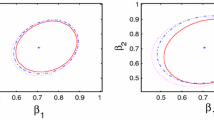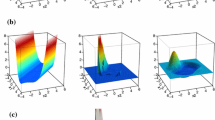Abstract
This paper is concerned with the bivariate transvariation theory. It presents an historical account of the subject and a development of the theory. It deals with the probability of transvariation and its related concepts, namely, transvariability and its maximum; the rth moment of transvariation, its maximum and the rth intensity of transvariation; area of transvariation and discriminative value. These concepts are developed without parametric constraint and under the assumption of Gaussian distribution. The sample variances and covariances of the transvariation parameters estimators are herein deduced. The applications, performed on economic variables, underline the fruitfulness of transvariation theory as a quantitative method to deal with comparative statics analysis.






Similar content being viewed by others
Notes
If \(\mathbb {R}^2\) contains no subsets of P-measure zero, then the condition is if and only if.
Sources: United States, Bureau Bureau of the Census, Statistical Abstract of the United States, 1967. Argentina, Dirección Nacional de Estadística y Censos, Costo de Vida, E.S. 60, Enero 1968.
References
Gini, C.: Il Concetto di “transvariazione” e le sue prime applicazioni. Athenaeum (1916)
Dagum, C.: Teoria de la transvariación: sus aplicaciones a la economia. Istituto di Statistica, Univ. degli Studi di Roma (1960)
Author information
Authors and Affiliations
Corresponding author
Additional information
Editors’ Note: This version of the paper has been edited by Francesco Dotto, research fellow at the Department of Statistical Sciences, University of Rome “La Sapienza”, email:francesco.dotto@uniroma1.it.
A longer version of this paper was released as research Memorandum No 99 of the Econometric Research Program at Princeton University in June 1968.
We would like to warmly thank Estela B. Dagum and Bo E. Honoré, Director of the Gregory C. Chow Econometric Research Program at Princeton University, for their authorization to publish the paper in this special issue.
Original Note: The subject of this paper was discussed in the Econometric Research Program Seminar under the direction of Professor Oskar Morgenstern and in the Department of Statistics Seminar under the direction of Professor John W. Tukey. The author is very much indebted to them for their interest in the subject and stimulating comments. The author expresses his appreciation to Mr. Peter Kaminsky, a Princeton University student, for his diligence and collaboration in preparing the final English version.
Rights and permissions
About this article
Cite this article
Dagum, C. Nonparametric and Gaussian bivariate transvariation theory: its applications to economics. METRON 75, 141–160 (2017). https://doi.org/10.1007/s40300-017-0113-3
Received:
Accepted:
Published:
Issue Date:
DOI: https://doi.org/10.1007/s40300-017-0113-3




